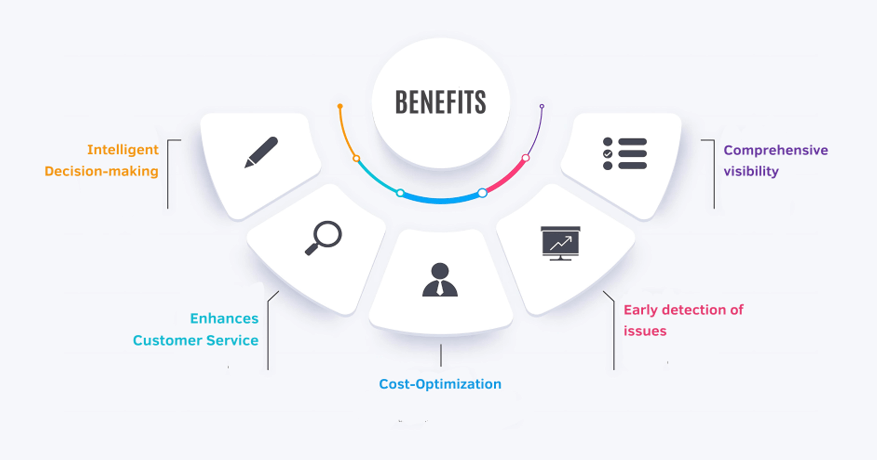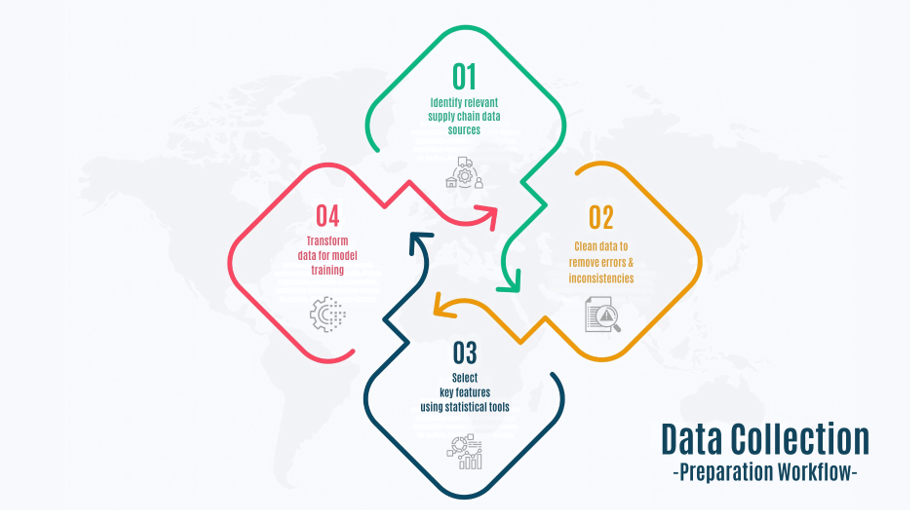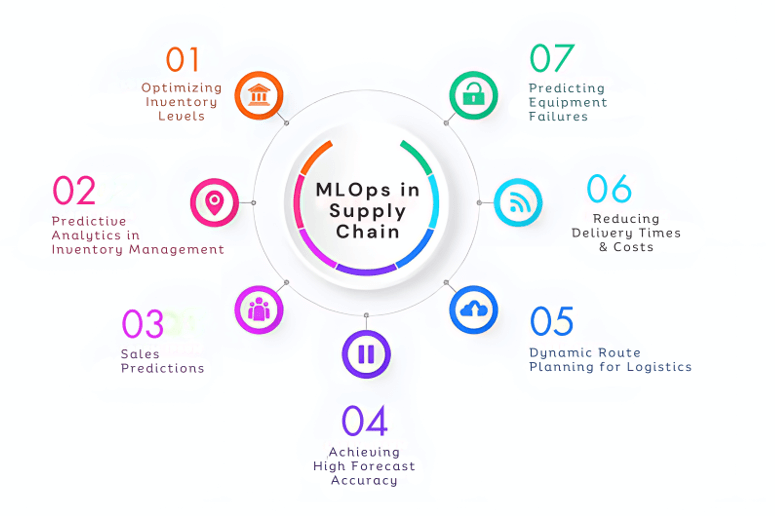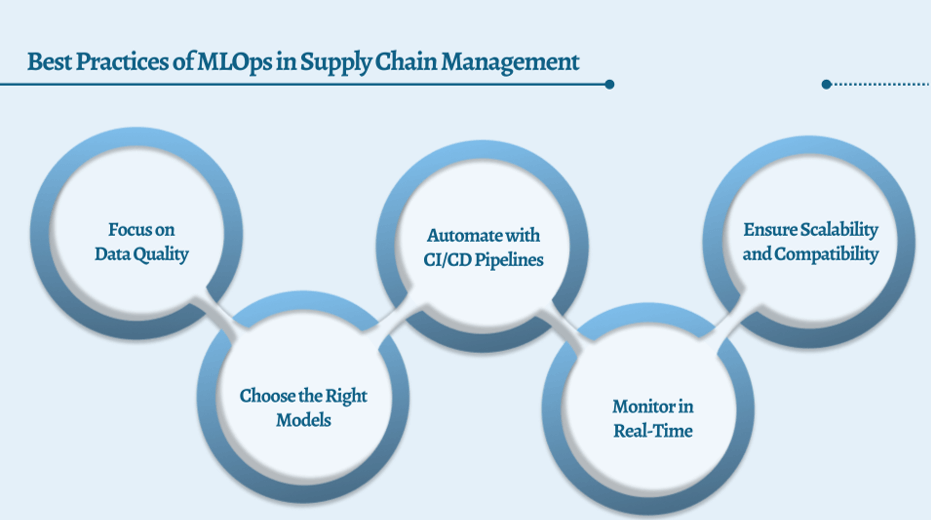Is the current supply chain prepared to handle market fluctuations? Inefficient planning risks disruptions and excess inventory. Research by McKinsey indicates that businesses leveraging AI and ML in their supply chains can reduce logistics costs by 15%, inventory levels by 35%, and enhance service levels by 65%.
MLOps significantly contributes to this optimization by efficiently processing vast amounts of data, refining model development, and ensuring continuous monitoring. By integrating MLOps, supply chains benefit from enhanced forecasting, demand sensing, and automated decisions, leading to improved operational performance.
This blog delves into how MLOps is shaping the future of supply chain management, highlighting key use cases and strategies for successful implementation.
What is MLOps?
MLOps, or Machine Learning Operations, refers to practices that enable the management and automation of the ML model lifecycle. It ensures that ML models transition smoothly from development to production, optimizing performance across your supply chain.
Core Components:
- Data Management: You start by gathering and cleaning data. This step is crucial to ensure the data is accurate and consistent. Additionally, versioning the data helps maintain traceability throughout the lifecycle.
- Model Development: During this phase, you train machine learning models using different algorithms. Tracking model versions helps you compare results and choose the best-performing model.
- Model Deployment: After training, you move the model into production. This process involves packaging the model and deploying it in a live environment.
- Monitoring and Maintenance: To detect issues like model drift, you should monitor the model’s performance.
We have seen MLOps and their components so far. Now, let’s examine their role in Supply Chain Management.
The Role of MLOps in Supply Chain Management
MLOps is the key to transforming your supply chain management. When you integrate machine learning models, you can streamline your operations and automate tasks like demand forecasting and inventory management.
Furthermore, with MLOps, you can continuously monitor model performance and adapt to market changes to ensure reliability. Ultimately, MLOps improves efficiency and agility in your supply chain, positioning you for success in a competitive market. The following image highlights the key benefits of MLOps in Supply Chain Management.

- Increased Agility: MLOps use real-time data analytics and automated model updates to identify shifts in market conditions. With fresh data, your MLOps model quickly adjusts forecasts and recommendations based on the latest trends.
- Improved compliance and Governance: With MLOps, you can implement automated monitoring and validation processes. This involves tracking model performance against compliance metrics and maintaining thorough documentation for audits.
- Managing the Complexity of Supply Chain Networks: MLOps employ data integration techniques to consolidate information from multiple sources. This helps to create a comprehensive view of your supply chain.
- Adapting to fluctuating Market Demands: MLOps uses predictive analytics to analyze historical data and current trends. The process generates forecasts that account for variability. With this information, you can adjust operations and inventory levels proactively in response to expected changes.
- Ensuring Model Reliability and Minimizing Decay: To maintain accuracy, you can incorporate continuous model monitoring and retraining protocols. When you update your models with new data and validate their performance, you mitigate the risk of model decay due to changing data patterns.
Now that you clearly understand the benefits, let’s move on to how to implement MLOps in Supply Chain. Also read our latest blog on RPA in Digital Transformation
Steps for Implementing MLOps in Supply Chain
Integrating MLOps into your supply chain management requires a structured approach. Here, you should focus on data quality, model development, continuous monitoring, and integration with existing systems. These steps will help you maximize the efficiency and accuracy of your machine-learning models.
1. Data Collection and Preparation
The key to successful machine-learning models is good data. You need the right information that is complete, correct, and pertinent. The data can come from various sources, such as:
- Sales records
- Inventory logs
- Supplier data
- Customer behavior patterns
Techniques for Data Collection and Preparation
- Start by identifying and removing any errors, duplicates, and inconsistencies in your data.
- Next, identify the most relevant variables (features) that will impact your model’s predictions. You’ll need to perform statistical analysis and use domain expertise to do this.
- Finally, transform your data into formats ready for analysis. This could involve normalizing numerical data, encoding categorical variables, or even creating new features from existing data.
Data Collection and Preparation Workflow:
- Step 1: Identify data sources relevant to supply chain operations.
- Step 2: Apply data cleaning techniques to remove errors and inconsistencies.
- Step 3: Use statistical tools to select the most impactful features.
- Step 4: Prepare and transform data for model training.
2. Model Development and Deployment
Selecting a suitable model is crucial. Different tasks within your supply chain require different types of models. For example:
- Time Series Models: Best for forecasting demand or predicting trends.
- Regression Models: Useful for predicting continuous variables, such as the number of products needed.
- Classification Models: Ideal for categorizing items, such as determining whether a product is at stockout risk.
Best Practices for Deploying Models in a Production Environment:
- Package your models using tools like Docker. This ensures consistent deployment across different environments, eliminating compatibility issues.
- Implement Continuous Integration/Continuous Deployment (CI/CD) pipelines. These pipelines automate the testing and deployment of your models.
- Set up real-time monitoring systems to track model performance after deployment. Create feedback loops to adjust models on the outcomes.
Model Development and Deployment Workflow:
- Step 1: Select the model type based on the specific task (e.g., time series for forecasting).
- Step 2: Develop and validate the model using historical data.
- Step 3: Package the model using containerization tools.
- Step 4: Deploy the model via CI/CD pipelines and set up monitoring systems.
3. Continuous Monitoring and Retraining
Over time, your models’ accuracy may degrade due to changes in underlying data patterns. Hence, you need to monitor this drift continuously and detect it early. For this, you need tools that provide real-time insights into model performance. Additionally, these tools will track metrics like accuracy, precision, and recall.
Automated Retraining Strategies to Maintain Model Accuracy Over Time
- Using the latest data, set up pipelines that automatically retrain models at regular intervals.
- Implement systems that trigger retraining in response to significant drops in model accuracy or the introduction of new data trends.
Monitoring and Retraining Workflow:
- Step 1: Set up real-time monitoring dashboards for key performance metrics.
- Step 2: Establish thresholds for performance indicators that trigger retraining.
- Step 3: Automate the retraining process using pipelines that incorporate new data.
- Step 4: Validate and redeploy the retrained models to ensure continued accuracy
4. Integration with Existing Systems
Use APIs to connect machine learning models with existing supply chain management tools. Furthermore, you should also consider modular integration. Here, you can integrate each component of the MLOps system to form a larger supply chain infrastructure.
Importance of Ensuring Compatibility and Scalability
- Compatibility: Ensure your MLOps tools and platforms are compatible with your current technology stack.
- Scalability: Design your MLOps framework to scale as your supply chain operations grow. This could involve adopting cloud-based solutions that offer flexible resource allocation and scaling capabilities.
Integration Workflow:
- Step 1: Assess your current supply chain management software for compatibility with MLOps tools.
- Step 2: Develop APIs to enable seamless integration between models and software.
- Step 3: Implement modular integration for ease of maintenance and upgrades.
- Step 4: Ensure the MLOps infrastructure is scalable to handle increasing data and computational demands.
Now that you have a solid foundation, let’s examine how those MLOps strategies manifest in supply chain use cases.
Use Cases of MLOps in Supply Chain
MLOps is becoming increasingly crucial in supply chain management, where data-driven models and automation can optimize processes. Let’s review some key applications of MLOps in supply chain management and the steps to achieve them.
Optimizing Inventory Levels
With MLOps, you take control of inventory optimization. You start by analyzing real-time sales data, allowing you to predict product demand accurately. You then use this data to adjust inventory levels dynamically, minimizing stockouts and lowering storage costs.
Steps to Achieve:
- Data Collection: First, you gather real-time sales and inventory data from all your distribution points.
- Data Cleaning: Next, you remove any inconsistent or duplicate data to ensure that your data is accurate.
- Model Development: You build predictive models that analyze this data to forecast demand for different products.
- Model Training: You continuously train these models using historical and real-time data to refine their accuracy.
- Integration: You integrate these models with your inventory management system, enabling dynamic, prediction-based adjustments.
- Implementation: Finally, you use the insights from these models to adjust inventory levels, keeping stock at optimal levels.
Predictive Analytics in Inventory Management
You can leverage MLOps to improve inventory accuracy through predictive analytics. You can optimize stock levels across different locations or product lines by analyzing historical sales data. This approach helps you maintain the right inventory levels in the locations where they are needed most.
Steps to Achieve:
- Historical Data Analysis: Start by collecting and analyzing historical sales data and customer purchase patterns.
- Behavioral Analysis: Next, incorporate customer behavior insights into your predictive models to better understand demand fluctuations.
- Model Creation: You develop models that predict future inventory needs based on past trends and customer behavior.
- Validation: Then, you validate these models with current data to ensure they provide accurate predictions.
- System Integration: You integrate these models with your inventory management systems, allowing for proactive stock adjustments.
Sales Predictions
MLOps improves the accuracy of your sales forecasts. You use models that are continuously updated with the latest data. These models take into account factors like seasonality, market trends, and economic indicators.
Steps to Achieve:
- Collecting Data: Start by collecting data on sales trends, market conditions, and economic indicators
- Seasonal Adjusting: Make sure your models can take into account any seasonality or other time-based factors.
- Build Models: You build models using these variables to predict better sales.
- Ongoing Update: Regularly update your model & you will always stay informed.
- Application: Use these predictions to adjust your inventory and production plans, ensuring you meet demand efficiently.
Achieving High Forecast Accuracy
When you integrate MLOps into demand forecasting, you start predicting future sales more accurately. This precision leads to better inventory management, more effective pricing strategies, and higher customer satisfaction.
Steps to Achieve:
- Advanced Analytics: First, you use advanced analytics to enhance your demand forecasting models.
- Continuous Improvement: Regularly review these models. Improve them based on their performance.
- Integration: Integrate the enhanced models into your sales and inventory planning systems.
- Feedback Loops: Set up feedback loops. Compare model outcomes to actual sales and refine the models accordingly.
Dynamic Route Planning for Logistics
You can use MLOps to optimize delivery routes. By analyzing real-time data such as traffic, weather, and delivery schedules, MLOps helps you identify the most efficient routes. This reduces fuel consumption and shortens delivery times.
Steps to Achieve:
- Real-Time Data Collection: Start by gathering real-time data on traffic, weather, and delivery schedules.
- Model Creation: Develop models that analyze this data. These models suggest the most efficient delivery routes.
- Implementation: Implement these models in your logistics operations. Use them to optimize route planning.
- Continuous Monitoring: Monitor the effectiveness of the routes continuously. Adjust the models as needed.
Reducing Delivery Times and Costs
With MLOps, you gain the flexibility to adapt to changing conditions on the ground. This adaptability helps you reduce delivery times and operational costs. Your logistics operations become more efficient and responsive to customer needs.
Steps to Achieve:
- Adaptive Models: Develop models that can adapt to real-time changes in logistics conditions.
- Integration: Integrate these models into your logistics management system.
- Real-Time Adjustments: Use the models to adjust delivery routes and schedules in real time.
- Efficiency Tracking: Track efficiency gains continuously and refine the models to improve them.
Predicting Equipment Failures to Prevent Downtime
You can use MLOps to monitor machinery health and predict potential outages. MLOps models can analyze the data provided by sensor applications to give an early warning of impending issues. This allows you to schedule maintenance instead of having unscheduled downtime.
Steps to Achieve:
- Sensor Integration: Equip your machinery with sensors to generate real-time operational data.
- Analyze Data: Develop models to analyze this sensor data. These models sense patterns that can be signs of incipient failures.
- Alerts: Implement predictive alerts to notify your maintenance teams before failures occur.
- Scheduled Maintenance: Use the insights from these models to schedule timely maintenance and prevent unexpected downtime.
Let’s take an example from the automobile industry to illustrate the impact of MLOps. When implemented, MLOps helps gain control over vehicle parts inventory by analysing real-time sales data. This enables accurate demand forecasting for different car models, ensuring that dealerships maintain the right stock levels while avoiding shortages and excess inventory.
As sales forecasts improve, market trends and seasonal fluctuations in consumer preferences are evaluated. This insight enhances demand predictions and optimizes logistics. MLOps also facilitates dynamic adjustments in vehicle delivery routes, reducing transportation costs and ensuring timely deliveries. Additionally, predictive maintenance monitors machinery health, preventing unexpected breakdowns on the assembly line.
With these improvements in place, applying MLOps in supply chain management can drive significant operational efficiency and cost savings.
Best Practices of MLOps in Supply Chain Management
To implement MLOps effectively in your supply chain, follow these best practices:
- Focus on Data Quality:
- Collect accurate data from all relevant sources.
- Clean and prepare the data thoroughly before using it to train models.
- Choose the Right Models:
- Select models that align with specific supply chain tasks.
- Validate these models using both historical and real-time data.
- Automate with CI/CD Pipelines:
- Set up Continuous Integration and Deployment pipelines.
- Automate testing and deployment to reduce errors and speed up processes.
- Monitor in Real-Time:
- Establish systems to track model performance continuously.
- Monitoring is used to detect and immediately address issues like model drift.
- Ensure Scalability and Compatibility:
- Design your MLOps framework to scale as your operations grow.
- Ensure seamless integration with existing systems for smooth operation.
These practices will enhance your supply chain’s efficiency and accuracy, leading to better decisions and cost savings.
Parting Thoughts
Incorporating MLOps into supply chain management offers transformative benefits, such as accurate demand forecasting, optimized logistics, and proactive inventory management. By leveraging machine learning models for predictive insights, businesses can enhance efficiency and minimize risks associated with overstocking or shortages. As supply chains become increasingly complex, adopting MLOps ensures that companies remain agile, data-driven, and competitive in a dynamic marketplace. Embracing these practices can result in more resilient and scalable operations, setting the stage for long-term success in the supply chain sector.
Calsoft, with its deep domain expertise and established processes, provides targeted solutions that are both secure and smart; to help supply chain digitally transform the way they do business.



